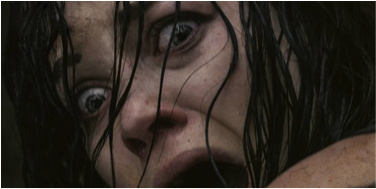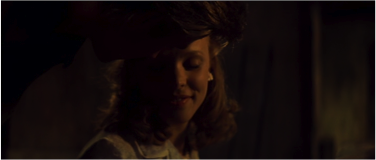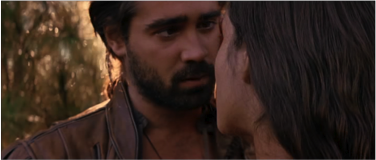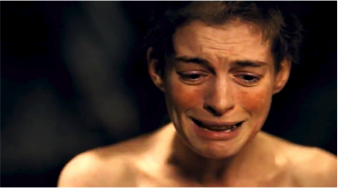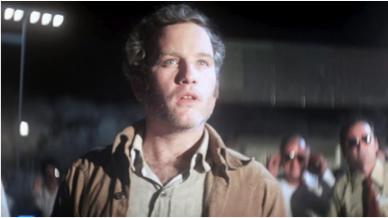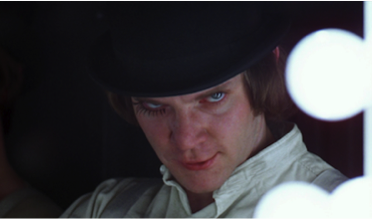The Face
Anna Swenson
“In a truly artistic film the dramatic climax between two people will always be shown as a dialogue of facial expressions in close-up”[1] Béla Balázs, 1924.
Since Balázs began the conversation in the early twentieth century, discussion of the filmic close-up has evolved. Where we have landed today in popular American filmmaking leans toward a filmic trend saturated with intensity: close-ups, accelerated continuity, explosions, complex camera movement, extensive visual effects and sound design. No wonder so many films lack a certain nuance of emotion and subtlety in performance. What such films may lack in emotion innate to their stories is usually made up for by emotional manipulation, particularly in the use of facial close ups: representations of the human face, to which we, as audiences, are so attracted. Our eyes naturally find the eyes of the actor. Our sympathy and empathy attaches itself to a perceived soul on the screen. It is the face, which directs our emotional experience of a film.
Roland Barthes’ “The Face of Garbo” describes the effectiveness of her face as seen in cinema, which is applicable to almost any on screen close up:
[…] in this deified face, something sharper than a mask is looming: a kind of voluntary and therefore human relation between the curve of the nostrils and the arch of the eyebrows; a rare, individual function relating two regions of the face. A mask is but a sum of lines; a face, on the contrary, is above all their thematic harmony. Garbo’s face represents this fragile moment when the cinema is about to draw an existential from an essential beauty, when the archetype leans towards the fascination of mortal faces, when the clarity of the flesh as essence yields its place to a lyricism of Woman.[2]
Barthes illuminates the intangible, and often indescribable, why behind the effect the human face can have on audiences. The face has the “it” factor. The eyes are the window to the soul. The mouth tells a million secrets without uttering a single word. In her book Fetishism and Curiosity, Laura Mulvey describes the particular nature of the female facial close-up in terms of Marilyn Monroe: “[…] its investment in surface is so intense that it seems to suggest that the surface conceals ‘ something else.’”[3] Mulvey analyzes Monroe’s face, discussing how its effect exceeds the obvious surface appeal of sexuality and commodity. Here, I similarly consider how the cinematic close-up can exceed its individual significance, relying instead upon an archetypal, emotional effect. While an individual face shown in close-up offers an intense image in its own right – confronting the audience with detail and scale – it nevertheless forces the audience to recognize a deeper, emotional significance. Just as Marilyn’s image and face came to represent female sexuality, different types of faces in close up have come to represent pure emotions, as appropriate to the film at hand. While this description does work generally, it will be especially helpful in looking at specific types of faces. Several of these types include the “terror face,” the “love face,” the “sorrowful face,” and even the “Spielberg Face” and “Kubrick Stare.”[4] In short, any intended emotion a film might attempt to convey can be boiled down to the faces in the film, particularly the faces shown in close-up.
In wanting to be taken into whatever experience a specific film is offering, filmgoers recognize the physical indicators, the cues of specific emotions (wide eyes and open mouth = horror), allowing themselves to give in to the film. The most skillful actors and directors, however, are able to truly evoke authentic emotion in an audience member. There is something about the face that makes us scared, as opposed to merely allowing us to know a character is scared in a film. Granted, music, sound effects, lighting and all other factors contribute to the emotional effect, but it is the face that makes us emotional: the “Spielberg Face” that makes us wonder, the “Kubrick Stare” that makes us psychotic, the horror face that makes us scared (Figure 1, Figure 2), the love face that makes us fall in love (Figure 3, Figure 4), and the sorrow face that makes us sad (Figure 5, Figure 6).
Taking a moment to clarify the difference between the facial close-up as a cheap shortcut versus a genuine hotline to evocative emotion, let us look closer at the Spielberg Face. Robin Wood explores two of Steven Spielberg’s most recognizable films, Close Encounters of the Third Kind (1977), and E.T. (1982). These were two of the earliest films to give evidence of this typical Spielberg face (Figure 7); they, and this time period in Spielberg’s very productive career, seem to crystallize its representation. Much of Wood’s analysis revolves around Reagan Era-anxiety, but he also inadvertently discusses the facial close-up and the effects it has on Spielberg’s audiences. One of the reasons this “Spielberg Face” is so effective has to do with Spielberg’s own “genuine” and “sincere” approach to his films. “Spielberg’s characters, like his audiences” (and like Spielberg himself?) “typically look up in childlike wonder at the spectacle he provides them.”[5] In Spielberg’s case, this “wondrous” emotion on the faces of his actors is that much more believable because the whole philosophy behind his films coalesces into this idea of wonder; and in that, Spielberg has shaped this face of “eyes open, staring in wordless wonder in a moment where time stands still,”[6] now recognizable as a signature aspect of Spielberg’s films.
The “Kubrick Stare” (Figure 8), an intense stare from under the eyebrows of his actors, implies a disturbance in the character’s psyche. It can be seen in A Clockwork Orange in Alex DeLarge, in The Shining in Jack Torrance, and in Full Metal Jacket in Private Pyle. This face carries a specific connotation of a psychotic nature. The director’s intent is clear, and the actor’s execution is skillful, but the close-up makes it stand out.
The fact that these faces are rendered in close-up signifies their intent of nearly pure manipulation in their ability to evoke emotion. Mary Ann Doane describes this phenomenological experience in her article “The Close-Up: Scale and Detail in the Cinema:”
The close-up has inspired fascination, love, horror, empathy, pain, unease. It has been seen as the vehicle of the star, the privileged receptacle of affect, of passion, the guarantee of the cinema’s status as a universal language, one of, if not the most recognizable units of cinematic discourse, yet simultaneously extraordinarily difficult to define.[7]
Similarly, Christian Metz points out the particular emphasis close-ups place on whatever they are framing, the face not excluded. “A close-up of a revolver does not mean ‘revolver’ (a purely virtual lexical unit), but at the very least, and without speaking of the connotations, it signifies ‘Here is a revolver!’ It carries with it a kind of here.”[8] Any close-up necessarily implies a particular significance. Furthermore, because of the nature of the face and the audience’s desire to connect with it, the facial close-up places specific emphasis on depicting emotions. This precise signifier of the aforementioned emotional beat, again, has much to do with Balázs’ assumption that “what makes objects expressive are the human expressions projected on them.”[9] Humans connect by projecting part of themselves onto whatever it is they are viewing. The “Kuleshov effect” has much to do with this application, in that an audience perceives love (or any emotion) through a series of faces and/or images, such as two actors looking at one another. If the actors had completely blank faces, audiences would still be likely to imprint something onto the exchange. When actors are projecting emotions, it makes audiences that much more willing and likely to read into the faces whatever they can. The simple fact that one character may gaze upon another implies something. What that something is depends on the emotion, the mood, and the projected human expression.
Just as wide eyes, an open mouth and furrowed brow signify the “horror face” (Figure 1, Figure 2), soft features along with large, intense, happy, and/or admiring eyes can generalize the “love face,” (Figure 3, Figure 4). Similarly, and yet in a completely different way, the “sorrow face” comes through in squinted, narrow or crying eyes and tight or mouth (Figure 5, Figure 6). While each of these film stills is completely open to interpretation, there is little argument that can be made against the general emotion being conveyed – fear, love and sadness, respectively. And while the physical cues are present, the real effect comes from that “thematic harmony,” which exists behind and beyond “the curve of the nostrils and the arch of the eyebrows.”[10]
Other faces exist in film history beyond number, and as many more will soon be made, but these basic truths of the face hold true. The “Spielberg Face” showcases child-like wonder, the “Kubrick Stare” exudes seven kinds of crazy, and “love,” “sorrow” and “horror faces” are aptly named. Directors have developed their own types of faces through their film repertoire and actors bring skillful depiction in addition to having the most important thing already: a face. There are countless successful ways to portray emotions in a film, but these close-ups are perhaps perfectly fitted for the types of stories told in Hollywood cinema: those focused on the individual and his/her personal experiences. If the eyes are the window to the soul, then the filmic close-up is the window into character emotion.
Anna Swenson is a Film and Television MFA graduate from The Savannah College of Art and Design (SCAD). Her track focused on film editing, and she was honored with SCAD’s award for best editing of a graduate film in 2013. She has a specific interest in exploring how emotion is instilled into motion pictures; as an editor, she feels one of her primary jobs is to appropriately convey emotion, and to analytically explore new techniques.
1 Bela Balazs, preface to Visible Man, cited from the translation by Erica Carter and Rodney Livingstone, in Bela Balazs: “Visible Man, or the Culture of Film” (1924). In: Screen, 48, 1, 2007: 91-108.
2 Roland Barthes, “The Face of Garbo,” Mythologies (1957): 57.
3 Laura Mulvey, Fetishism and Curiosity, (Bloomington: Indiana UP, 1996), 48.
4 In 2011, Kevin Lee produced a video essay showcasing a mash-up of Spielberg close-ups, entitled “Essential Viewing: The Spielberg Face.” Inspiration for his video essay came largely from a photo essay by Matt Patches (published on UGO) entitled, “The Spielberg Face: A Legacy.” The “Spielberg Face” has been around since Spielberg’s first films. Gradually, scholars, critics and fans have been defining it. In 1977, Roland Barthes used one of the same key phrases Kevin Lee employs, that of describing the “Spielberg Face” as one portraying “childlike wonder.”
5 Robin Wood, Papering the Cracks: Fantasy and Ideology in the Reagan Era, ed. John Belton (New Brunswick: Rutgers, 2000), 216-218.
6 Lee, Kevin. “Essential Viewing: The Spielberg Face.” Keyframe Explore the World of Film. N.p., 13 Dec. 2011. Web. 15 Apr. 2013.
7 Mary Ann Doane, “The Close-Up: Scale and Detail in the Cinema,” Differences: A Journal of Feminist Cultural Studies, 14:3 (2003): 90.
8 Christian Metz, Film Language: A Semiotics of the Cinema. Trans. Michael Taylor (New York: Oxford UP, 1974) 67.
9 Béla Balázs, Theory of the Film: Character and Growth of a New Art. Trans. Edith Bone (New York: Dover, 1970) 60.
10 Barthes, 57.


